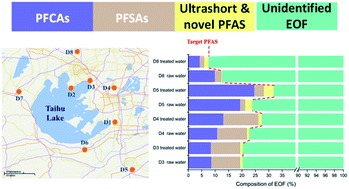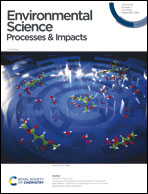A pilot study on extractable organofluorine and per- and polyfluoroalkyl substances (PFAS) in water from drinking water treatment plants around Taihu Lake, China: what is missed by target PFAS analysis?†
Abstract
Per- and polyfluoroalkyl substances (PFAS) have raised concerns due to their worldwide occurrence and adverse effects on both the environment and humans as well as posing challenges for monitoring. Further collection of information is required for a better understanding of their occurrence and the unknown fractions of the extractable organofluorine (EOF) not explained by commonly monitored target PFAS. In this study, eight pairs of raw and treated water were collected from drinking water treatment plants (DWTPs) around Taihu Lake in China and analyzed for EOF and 34 target PFAS. Mass balance analysis of organofluorine revealed that at least 68% of EOF could not be explained by target PFAS. Relatively higher total target concentrations were observed in 4 DWTPs (D1 to D4) when compared to other samples with the highest sum concentration up to 189 ng L−1. PFOA, PFOS and PFHxS were the abundant compounds. Suspect screening analysis identified 10 emerging PFAS (e.g., H-PFAAs, H-PFESAs and OBS) in addition to target PFAS in raw or treated water. The ratios PFBA/PFOA and PFBS/PFOS between previous and current studies showed significant replacements of short-chain to long-chain PFAS. The ratios of the measured PFAS concentrations to the guideline values showed that some of the treated drinking water exceeds guideline values, appealing for efforts on drinking water safety guarantee.

- This article is part of the themed collections: Recent Open Access Articles and Contaminant remediation and fate


 Please wait while we load your content...
Please wait while we load your content...